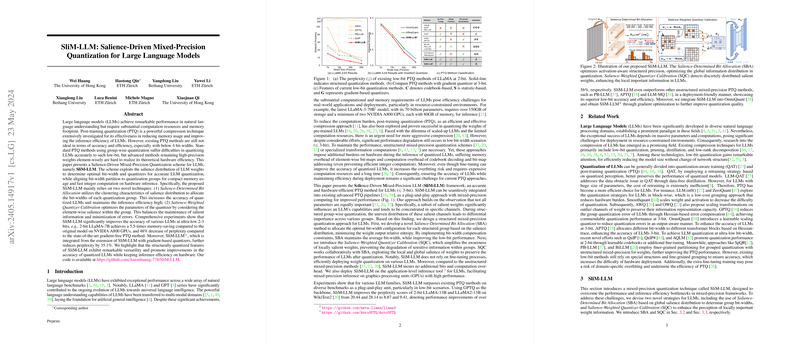An Analysis of SliM-LLM: Salience-Driven Mixed-Precision Quantization for Efficient LLM Deployment
The paper introduces SliM-LLM, a novel approach to efficient quantization of LLMs through salience-driven mixed-precision. As researchers continue to grapple with the computational demands and memory footprints of modern LLMs, effective post-training quantization (PTQ) methods remain essential to leverage these models in resource-constrained environments. This work addresses the shortcomings of existing PTQ methods, particularly at ultra-low bit-width levels.
Core Contributions and Techniques
The authors propose SliM-LLM, a quantization framework that optimizes the precision of model weights by considering the salience distribution—an assessment of weight importance based on their influence on model output. This approach introduces two primary innovations:
- Salience-Determined Bit Allocation (SBA): SBA allocates bit-widths to quantization groups based on their salience, integrating a structured approach to maintain high-inference efficiency. This technique divides weights into groups and assigns bit-widths by analyzing the importance ranking of these groups, effectively minimizing output information loss quantified via Kullback-Leibler divergence rather than traditional mean square error metrics.
- Salience-Weighted Quantizer Calibration (SQC): Focused on improving the quantizer's responsiveness to locally salient weights within groups, SQC utilizes search parameters to optimize the scale and zero-point configuration of the quantizer. This calibration is critical for maintaining a balance between preserving salient data and minimizing errors.
Numerical Results
The empirical evaluations show that SliM-LLM significantly outperforms existing methods like AWQ, GPTQ, and QuIP, especially in the 2-bit quantization scenario. For instance, the paper reports that a 2-bit quantization of LLaMA-7B achieves a 5.5-fold reduction in memory usage, significantly improving over existing gradient-free methods by reducing perplexity by 48%. The enhanced version, SliM-LLM+ which incorporates gradient-based quantizers, further reduces perplexity by 35.1%. Such results underscore the framework's proficiency in balancing the trade-off between accuracy and hardware efficiency.
Implications and Speculations on Future AI Development
From a practical standpoint, SliM-LLM enables the deployment of LLMs in environments with limited computational resources, thus broadening the applicability of such models to edge computing and real-time applications. The structured approach to mixed-precision quantization reduces the hardware burden traditionally associated with quantized models, paving the way for scalable and efficient AI solutions.
Theoretically, this work suggests that further exploration of salience-based techniques could extend beyond quantization to enhance various model compression strategies such as pruning or distillation. The emphasis on salience—where not all model parameters contribute equally to output—may influence broader model optimization paradigms.
Conclusion
In summary, SliM-LLM offers a promising advancement in PTQ, aiming to optimize the computational efficiency of LLMs while minimizing losses in accuracy. By leveraging the concept of salience, this framework addresses both the precision requirements and computational challenges in deploying LLMs in practical applications. Future research may build upon these insights, leading to even more sophisticated methodologies for AI model compression and deployment.
